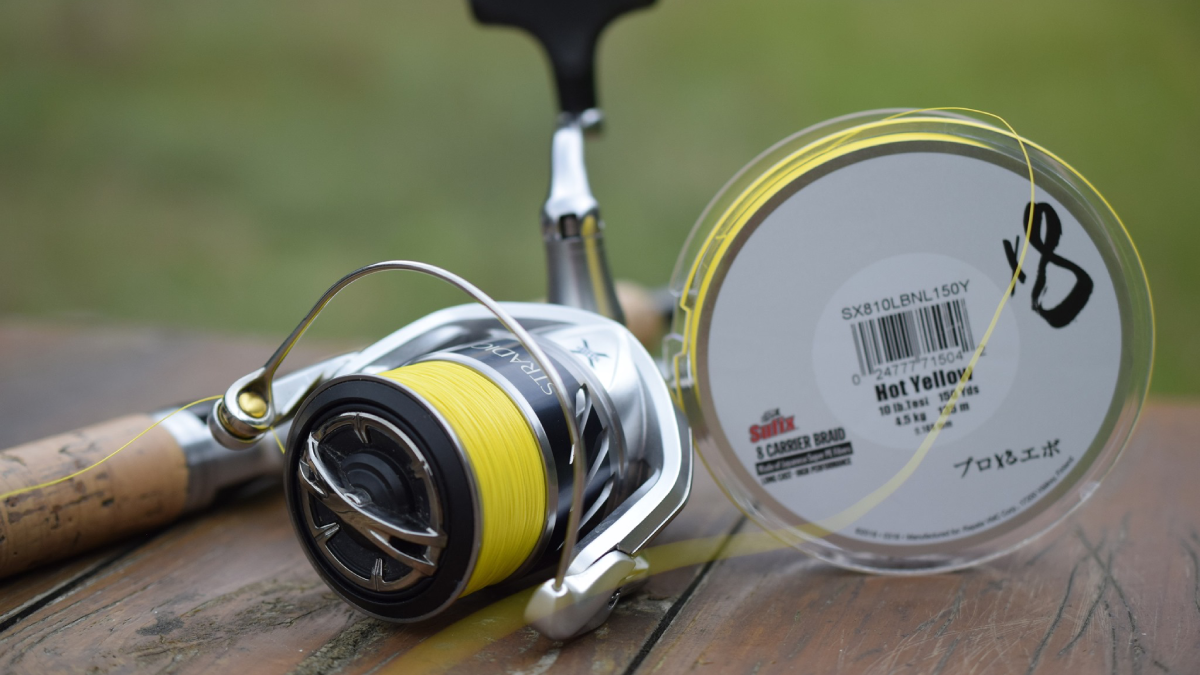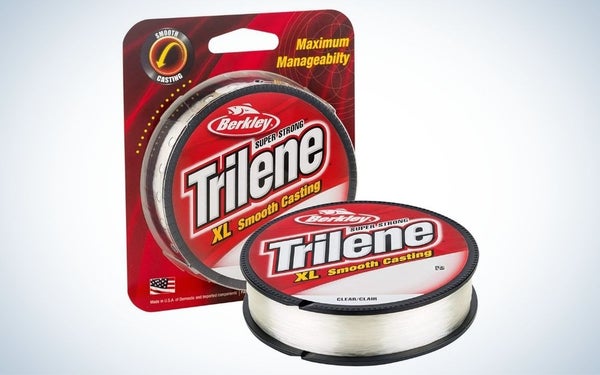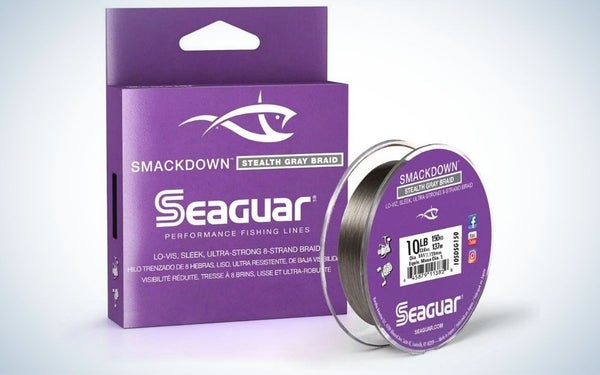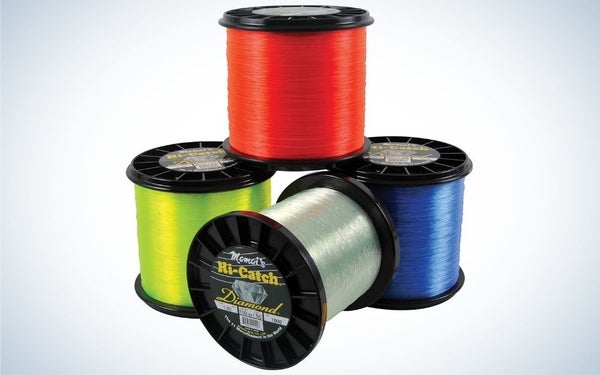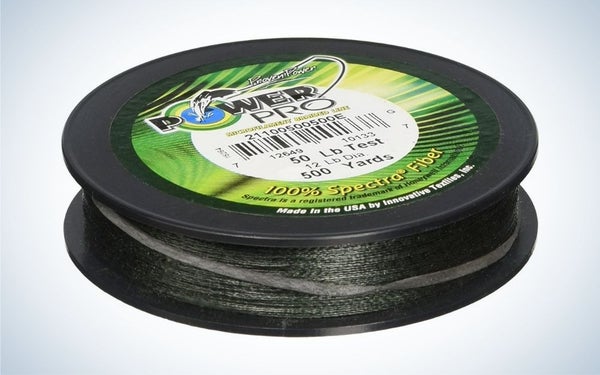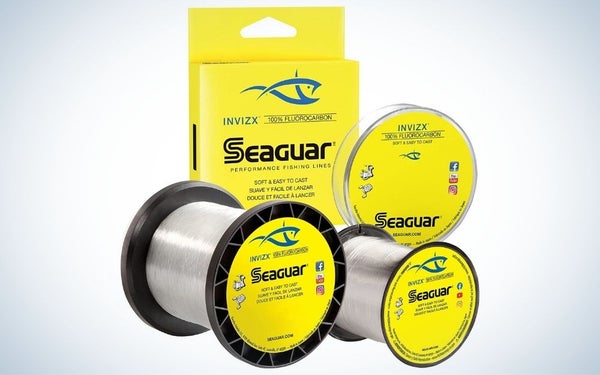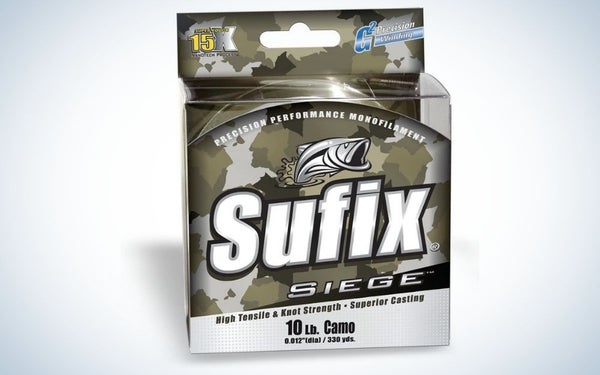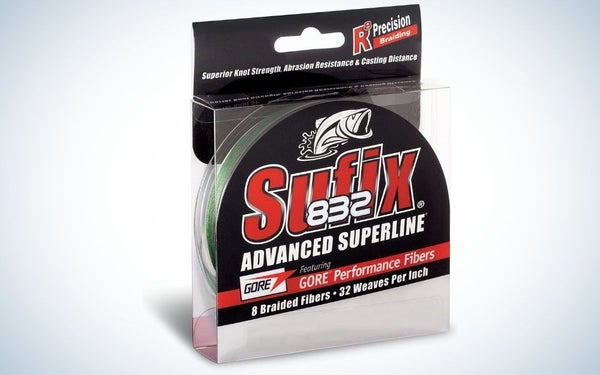| Best Mono |
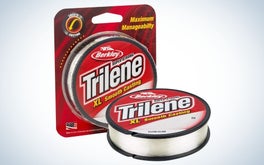
|
Berkley Trilene XL | SEE IT |
LEARN MORE
|
Summary
The “XL” on this Trilene label stands for “Extra Limp”, which means it’s super soft for smooth casting, no matter what style of reel. |
| Best Braid |
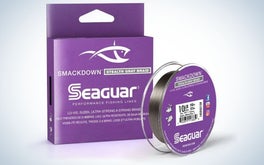
|
Seaguar Smackdown | SEE IT |
LEARN MORE
|
Summary
The tensile strength is outstanding for such a thin-diameter braid, with 10-pound test—the lightest offered for this brand—having the same diameter as 2-pound-test mono. |
| Best for Bass |
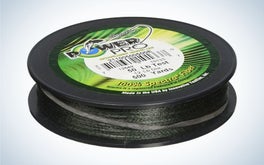
|
PowerPro | SEE IT |
LEARN MORE
|
Summary
Unlike other brands that have an oval shape—which causes friction on the spool and rod guides—PowerPro’s braided Spectra Fiber, treated with their Enhanced Body Technology, gives this braid a super-round shape and smooth texture. |
We may earn revenue from the products available on this page and participate in affiliate programs. Learn more ›
Having the best fishing line is often the most overlooked piece of the fishing-paraphernalia puzzle, yet, it’s definitely the most important item in any angler’s arsenal. After all, it’s the only connection between you and your catch.
While there’s no one type or brand to fit all scenarios, there are certain criteria to consider before spooling up. Maximum softness and stretch with monofilament (mono), little stretch of fluorocarbon (fluoro), or the nearly no stretch of braid are all crucial considerations. Soft and subtle verses being abrasion-resistant are other opinions to ponder.
Every fish species is diverse, coming in all shapes, sizes, and behaviors. Thus, the characteristics of fishing lines are also varied, from the best for bass to the best for trout. Below are the best fishing lines, whether you want to go into stealth mode, finessing fish with line that’s nearly invisible to a fish’s eyes, or opt for brightly colored line that helps you see subtle strikes with a mere twitch.
- Best Mono: Berkley Trilene XL
- Best Braid: Seaguar Smackdown
- Best for Saltwater: Momoi Hi-Catch Diamond
- Best for Bass: PowerPro
- Best for Crappie: Seaguar INVIZX 100% Fluorocarbon
- Best for Trout: Sufix Siege
- Best for Walleye: Sufix 832 Advanced Superline
How We Picked the Best Fishing Lines
As a fishing guide and outdoor writer that has fished from the Arctic Circle to Central Mexico and all points in-between, the amount of fishing line I have spooled and unspooled in my life would be a staggering number. And you’d be hard-pressed to find a brand and type that I haven’t tried. I’ve also been blessed to fish alongside an amazing list of professional anglers, hearing their reasons for the fishing line they prefer for different situations.
Here are some of the factors I used to make my selections:
- Durability: Nobody wants a fishing line that’s a one-and-done deal. Toughness, tensile strength, consistency, and longevity were all considered for the fishing lines that made the grade.
- Handling Characteristics: How stiff a line is directly affects its handling characteristics. I chose supple lines to minimize memory for excellent casting performance, but didn’t sacrifice durability to do so.
- Brand: It wasn’t just how long a company has been in business, but if they are innovators. There’s an overwhelming amount of fishing lines on the market today; some manufactures, however, have truly changed the face of sportfishing. I selected lines from reputable manufacturers that have proven themselves on the water for a long time.
- Price: Do you always get what you pay for? When it comes to fishing line, that tends to be the case. Some lines are surprisingly inexpensive, however, for a high-quality product, you pay a little more. I chose lines that offered value, but not at the expense of quality.
Best Fishing Lines: Reviews & Recommendations
Best Mono: Berkley Trilene XL
Specs
- Pound Test Ratings: 2-, 4-, 6-, 8-, 10-, 12-, 14-, 17-, 20-, 25-, 30-pounds
- Capacity: 110-, 250-, 270-, 300-, 330-, 1000-, 2300-, 2600-, 3000-yards
- Colors: Clear, Fluorescent Clear/Blue, Low-Vis Green
Pros
- Rarely kinks
- Excellent knot strength
- Great for novice and avid anglers alike
Cons
- Knicks and scuffs easily
- Less sensitive
This is the oldest fishing line brand tested. The “XL” on this Trilene label stands for “Extra Limp”, which means it’s super soft for smooth casting, no matter what style of reel. The modern-day formula’s made this line even more subtle, yet, stronger than the original. It’s also improved its knot strength by 20 percent, and has 50 percent greater strength when wet.
To boot, being 20 percent more flexible nowadays makes this line a great choice when teaching kids to cast, as it takes a lot of wear and tear before it kinks. While a good line for all reel styles, it’s manageability on spinning reels is most noticeable.
Best Braid: Seaguar Smackdown
Specs
- Pound Test Ratings: 10-, 15-, 20-, 30-, 40-, 50-, 65-pound
- Capacity: 150-yards
- Colors: Gray, Flash Green
Pros
- Seldom catches within a spool when casting
- Slices through weeds with ease
- Rarely needs replacing
Cons
- Takes a lot to fill a spool
- Expensive
Smackdown, the best braid fishing line is used in both fresh- and saltwater applications, and there is no discrepancy in wear and tear in either. When fished over rock piles and along jetties with barnacle-covered boulders, as well in waterways laden with timber, the abrasion resistance is noticeably top-notch.
This braid’s manufactured with eight ultra-thin micro-weave strands in a perfectly round shape, which has it coming off a reel’s spool smoothly. It was strikingly quieter than other braids as it slapped along a spinning reel spool’s lip during a cast, as well when running through guides on any rod. The tensile strength is outstanding for such a thin-diameter braid, with 10-pound test—the lightest offered for this brand—having the same diameter as 2-pound-test mono. It’s all the aforementioned that allows a lure to be placed with pinpoint accuracy with this braid.
Best for Saltwater: Momoi Hi-Catch Diamond
Specs
- Pound Test Ratings: 12-, 16-, 20-, 25-, 30-, 40-, 50-, 60-, 80-, 100-, 130-, 200-pound
- Capacity: 1000-yd, 3000-yd, 4-, 5- and 10-lb spools
- Colors: High-Vis Yellow, Brilliant Blue, Diamond Super Clear, Orange Crush
Pros
- Inexpensive compared to braid or fluoro
- Outstanding abrasion resistance
- Strongest mono with the same diameter as others
Cons
- Replace more often due to sunlight/UV damage
- Difficult hooksets in deep water
Being one of the thinnest monos on the market means you can load up a reel with quite a few extra yards of Momoi line, which surf anglers or anglers wanting to use smaller fishing reels than the norm appreciate.
The abrasion resistance of Momoi is a plus when fishing off piers and jetties; fish can wrap around a bolder or pillar, and there’s still a good chance of landing it over other monos. The line’s tinsel strength is up to 200% more than mono lines of the same diameter. Besides the fact mono floats, Hi-Catch Diamond’s softness also makes it a good choice for top-water fishing in inshore areas.
Best for Bass: PowerPro
Specs
- Pound-Test Ratings: 3-, 4- , 5- , 8- , 10- , 15- , 20- , 30- , 40- , 50- , 65- , 80- , 100- , 150- , 200- , 250-pound
- Capacity: 100-, 150-, 300-, 500-,1500-, 3000-yards
- Colors: Moss Green, Hi-Vis Yellow, Vermilion Red, White
Pros
- Near zero stretch
- Extreme abrasion resistance
- Value priced braid
Cons
- Difficult to untangle backlashes
- Problematic to break when snagged
Unlike other brands that have an oval shape—which causes friction on the spool and rod guides—PowerPro’s braided Spectra Fiber, treated with their Enhanced Body Technology, gives this braid a super-round shape and smooth texture. This makes it easier to cast further into heavy cover a boat can’t reach and making it one of the best fishing lines for bass.
With the drag cranked down, a fish can be turned and pulled out of thick cover that would certainly be a snaggy mess with mono or fluoro. The sensitivity of PowerPro makes it a great line for pitching up against standing timber as it’s easy to tell when a jig catches a limb, let alone telegraphing when a bass engulfs your bait. And when fishing lily pads and the like, baits are easily ripped free from the vegetation when caught up.
Best for Crappie: Seaguar INVIZX 100% Fluorocarbon
Specs
- Pound Test Ratings: 4-, 6-, 8-, 10-,12-, 15-, 17-, 20-, 25-pound
- Capacity: 200-, 600-, 1000-yards
- Colors: Clear
Pros
- Low stretch
- Nearly invisible
- Good knot strength
Cons
- Expensive
- Hard for vision-challenged anglers to tie knots in lighter tests
Seaguar invented fluorocarbon—bringing it to market in 1971—and they are the only brand that makes fluorocarbon lines and leaders from beginning to end, without any outside companies involved. This level of control over the manufacturing process translates to high quality in the finished product.
INVIZX 100% Fluorocarbon is impervious to UV rays, so it doesn’t have to be changed out as often as mono. Fluorocarbon’s inherent properties make it versatile. It sits perfectly vertical under a bobber due to its density, and its softness makes it a great line for casting tiny jigs and trolling small crankbaits. And with a refractive index similar to water, it all but disappears—hence why it’s our top pick for the best fishing line for crappie.
Best for Trout: Sufix Siege
Specs
- Pound Test Rating: 4-, 6-, 8-, 10-, 12-, 14-, 17-, 20-pound
- Capacity: 250-, 330-, 3000-yards
- Colors: Clear, Smoke Green, Neon Tangerine, Camo
Pros
- Offered in camouflage for concealment
- Very little line twist
- Economically priced
Cons
- Harder to set the hook with larger lures due to stretch
Slightly stiffer than some brands due to its outer coating for abrasion resistance—which is up to 15 times more than others in this category—Siege is very sensitive for mono and is one of the best fishing lines for trout. This makes it a great choice for feeling a hit when dabbling live bait and casting hardware in rivers and streams with heavy cover.
Right after spooling up with new line, it’s noticeable there’s very little memory due to the manufacturer’s exclusive G² Precision Winding, where the line is level-wound onto the manufacturer’s spool. This nearly eliminates line coiling off a spinning reel’s spool when opening the bail. The G² Precision Winding also eradicates flat spots, as well rolling and chaffs that can occur when spooled otherwise.
Its high tensile strength stands up to the tug of a trout when being pulled out from a log jam or undercut bank, and there’s a good chance you’ll get your lure back if you happen to snag a tree branch.
Best for Walleye: Sufix 832 Advanced Superline
Specs
- Pound Test Rating: 4-, 6-, 8-, 10-, 12-, 14-, 17-, 20-pounds
- Capacity: 250-, 330-, 3000-yards
- Colors: Clear, Smoke, Green, Neon Tangerine, Camo
Pros
- Offered in light-pound tests
- Many color options
- Retains its color
Cons
- Specific knots for braid needed
832 Advanced Superline has one of the tightest weaves on the market, at 32 (pics) per inch, including seven HMPE fibers and one additional GORE Performance Fiber. This makes it easier to cast lightweight baits like jigs and crankbaits a long way to areas where fickle walleyes roam without spooking them. The tight weave also steps up its abrasion resistance.
The advantage of the Gore strand within this braid helps it absorb less water (hydrophobic water-repellent protection) than other brands. This lets you cast the same distance on the last cast of the day as you did on the first. And unlike some other brands, TPG Technology enhances color retention, nipping dye fading in the bud. Make sure to check out some of our other favorite fishing lines for walleye.
What to Consider When Choosing Fishing Line
Where and what you’re fishing for have a big effect on the type of line you choose. Take a look at the following factors to help you decide which line is right for you.
Type of Fish
You wouldn’t use the same line for marlin that you do for crappie. Generally speaking, the bigger a fish is, the more power it has. Select lower pound tests for panfish, and heavier lines for larger predators. The type of cover that you’ll find a species of fish in also plays into this, as you’ll want the added strength to pull fish out of stump fields or rockpiles before they can break you off. In these instances, you may want the lower-stretch qualities of a braided line. But note that braid is usually not as abrasion-resistant as fluorocarbon or monofilament.
Water Clarity
Determine what type of water you’ll be fishing in most. While most fishing lines can be used in both fresh and saltwater, the water’s turbidity should be contemplated beforehand. Is the water clear enough that fish use their eyesight to see and attack your offering? Then the invisibility of lighter-pound-test clear fluoro or camo mono might be your best bet. Perhaps the water’s so stained they have to rely on their lateral line to dial in? Then you can probably get away with a heavier, brightly-colored braid.
Techniques
Next, decide what techniques you’ll use most. Fishing off a dock or on shore with live bait, perhaps with kids? Then line that’s subtle and casts easily is a must. If you’re into casting and retrieving large artificial baits, on the other hand, fishing line that can handle the shock of a swift swimming fish attacking your lure should be considered.
FAQs
Q: How much does fishing line really cost?
Overall, the larger a bulk spool you buy, the less you’ll be paying per yard. Just make sure to keep unused line, no matter what kind, in a cool, dry, and dark place.
Another deliberation is the type of line you use. While mono costs less upfront, it needs to be changed out more often because it breaks down from sunlight exposure, as well as contact with chemicals such as Deet found in bug repellent. Fluorocarbon is more expensive, but is unaffected by sunlight. Thus it needs to be changed less often. And while braid can give you sticker shock at the checkout counter, it can last ten times longer than mono.
Q: What color fishing line is best?
The list of colors to choose from is long, but there are a couple general rules of thumb to contemplate, and that’s water clarity and how fast your presentation is. If you’re fishing stained water or ripping big baits through an area, you can get away with the brighter, easier-to-see lines. For techniques that require a slow presentation, the more invisible your line’s appearance, the more bites you’ll get.
Q: How do I tie braided fishing line?
There are many knots you can use to tie braided line. The best way to describe it is by diagram, and we have a great article about the strongest fishing knots to show you how to get started.
Best Fishing Lines: Final Thoughts
- Best Mono: Berkley Trilene XL
- Best Braid: Seaguar Smackdown
- Best for Saltwater: Momoi Hi-Catch Diamond
- Best for Bass: PowerPro
- Best for Crappie: Seaguar INVIZX 100% Fluorocarbon
- Best for Trout: Sufix Siege
- Best for Walleye: Sufix 832 Advanced Superline
You may have the lightest, most sensitive, high-quality rod and reel known to the fishing world. But if you’re spooling it all up with cheesy line, you’d be better off giving up and heading for the fish market. After all, it’s the only link between you and a fish. Use the guide above to select the best fishing line for you and catch them up!
Why Trust Us
For more than 125 years, Field & Stream has been providing readers with honest and authentic coverage of outdoor gear. Our writers and editors eat, sleep, and breathe the outdoors, and that passion comes through in our product reviews. You can count on F&S to keep you up to date on the best new gear. And when we write about a product—whether it’s a bass lure or a backpack—we cover the good and the bad, so you know exactly what to expect before you decide to make a purchase.
